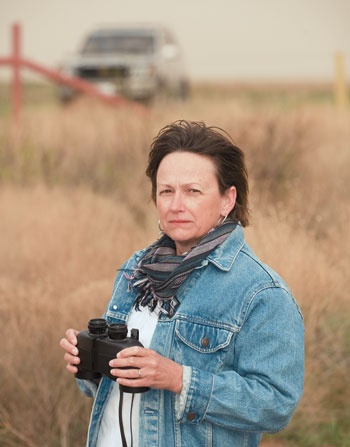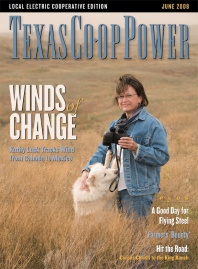Ten years ago, long before Texas became the nation’s largest producer of wind power with the largest wind farm, Big Spring real estate agent Kathy Lusk assisted a developer interested in finding wind power sites. Soon, Lusk became one of Texas’ first wind power scouts and started AKL Wind Energy Scouting.
“I learned on my own by going to wind sites and studying on the Internet. Scouting is not that far a stretch from what I did researching property ownership,” says Lusk, 49, a certified property manager who once managed a Big Spring mall.
Exploring likely wind farm areas, the West Texas native now drives thousands of miles a year in the region west of Interstate 35 between the Canadian and Mexican borders. Equipped with U.S. Geological Survey wind maps, Lusk and her 12 contractors scout potential sites usually at the request of a developer, although they sometimes prospect independently or at the landowners’ request. The ideal site is an uninhabited windy area with documented wind speed measurements that’s near roads and power transmission lines to population centers. Contractors also need owners interested in signing long-term leases.
“Wind power is a supplemental energy source that can prolong our finite resources,” Lusk says. A Master Gardener, a nature photographer and an advocate for native plants and wildlife habitat, she says that a love of nature drew her into the renewable energy field. Although Lusk became a wind power scout by chance, a passion and a preference for wind energy have kept her there and made her successful. “We can tell you pretty quickly whether a site will be profitable or not,” says Lusk, whose husband, Dan, now works with her. Basically, the farther wind-generated electricity must go to reach customers, the stronger the initial source must be.
The likelihood of a wind power scout showing up on your doorstep is growing as investment in wind energy increases in West Texas and the Panhandle. In 2008, Texas is scheduled to add more wind turbines than any other state. Lusk, who helps develop wind contracts, recommends becoming informed about what a wind power lease would mean for you and your property. Lusk agreed to answer general questions about wind energy leases for those lucky enough to have viable wind power property and those of us who at least would like to dream about it. Of course, if a lease becomes viable, one should always get legal advice about specific contracts.
What time frames are we looking at?
Most wind energy leases run for at least 15 years with 10-year renewal options. These are multi-generational leases, so you should get your immediate family involved. Realistically, it takes five to seven years from the time you first see my face to the time you get your first production check.
What are the basic components of a wind farm lease?
A lease should cover the three phases of the wind power development process: feasibility, construction and operations. In the first, or development phase, you are typically paid an option fee per acre while the site feasibility is researched.
In the construction phase, the landowner receives payments from the developer to install necessary cattle guards and fences and improve roads to handle heavy turbine parts. A lot of one-time payments occur during this phase, such as lost hunting lease revenue, damages for the holes where the towers are placed and a lay-down yard where the developer stages equipment.
What kind of input can I have on the construction?
The good developer will talk about placement with the landowner, who has the opportunity to request changes during the preliminary design stage. Examine the standard setbacks that set minimum distances from houses, barns and roads, including the construction crane’s 40-foot-wide path.
What should a landowner expect during this phase?
A project’s primary landowner will receive a royalty. If a wind farm site has multiple, small-tract owners, each acre nets a fixed percentage of production annually. That proportionate payment amount is set up front and trued up at the end of the year. The lease should state a minimum yearly payment per megawatt and guarantee you a payment even if part of the project is down.
What are the going rates for wind turbines in operation?
It varies widely depending on the developer, the size of the turbine and the location. The minimum payment is around 3 percent of gross. Turbines range from 1 to 3 megawatts. At the very least, you should receive about $4,000 per megawatt per year. A wind farm near a high electrical demand (load) area and a great source of wind means more money for the landowner and for the developer.
How does a wind power lease differ from an oil lease?
We deal with surface owners only. Wind cannot be severed from the surface of land and the right of capture. If the land is sold, the lease transfers to the new owner.
Why has no one asked about leasing my land where the wind is almost constant?
How far will the electricity travel to be delivered? Is a main power grid nearby to carry the electricity? The shorter the distance from the source to the load (or demand), the more viable the site. The Public Utilities Commission of Texas recently approved new power transmission lines that can help move future wind energy to urban areas.
What about turbines becoming dangerous at high speeds?
Even working at maximum power, a wind turbine does not spin as fast as a windmill pumping water. You see the newer generation turbines’ individual, 300-foot-long blades in motion. Wind turbines shut down or disconnect whenever winds go above 45 miles per hour.
“I don’t want them just everywhere, but I would like to see enough wind farms that we could get away from depending on finite sources and other countries for energy,” Lusk says.
Wind power’s a serious business, but she’s seen the lighter side, too, like when one Texas rancher told the wind developer that the developer would have to pay for cattle guards at entrances to the ranch. Then the developer—from New York—asked, “How much do you pay a cattle guard?”
——————–
Harlingen writer Eileen Mattei is a Nueces Electric Cooperative-Retail member.


